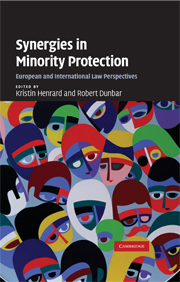1 - Introduction
Published online by Cambridge University Press: 21 July 2009
Summary
Introduction
‘Synergy’ is a word which conveys a range of meanings, and the particular ways in which it is understood for the purposes of this collection will be explored in this introduction. In our view, the notion of ‘synergy’ is particularly relevant to the protection of minorities in international law, owing to the diversity of relevant instruments and international institutions, and we shall therefore precede our discussion of the notion of ‘synergy’ with a broad summary of the most important developments in relation to minority protection, both at a global and at a regional level. We shall conclude with a consideration of the limits of the synergies explored in this collection, and with a speculation, informed by the contributions to this collection, on the future prospects for synergies in minority protection.
Broad developments in relation to minority protection at global and regional level
The broad history of the development of protection for minorities in international law is generally well known. So, too, are the limitations of the various mechanisms for minority protection which have existed at each stage in this development. Prior to the First World War, such protection as existed in international law was generally ad hoc, based primarily on bilateral treaties in response to particular conflicts or potential conflicts involving kin-groups or co-religionists. It was also usually limited in scope, and included only limitations on discrimination, a right to respect for freedom of religion, and, in some cases, a limited right to freedom of expression – or at least a freedom to use a minority language without restriction in private life.
- Type
- Chapter
- Information
- Synergies in Minority ProtectionEuropean and International Law Perspectives, pp. 1 - 20Publisher: Cambridge University PressPrint publication year: 2009
References
- 1
- Cited by



